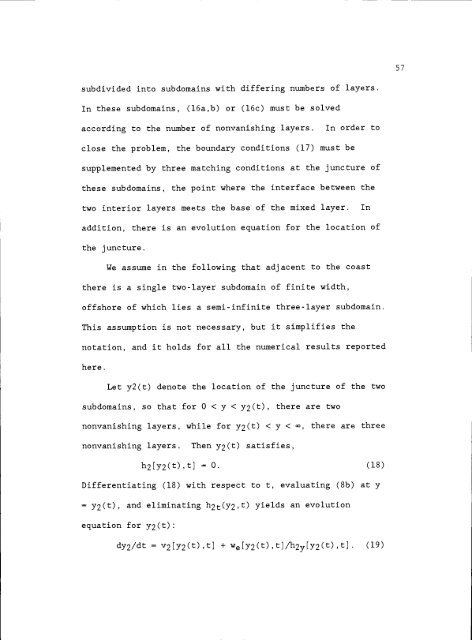Observations and Modelling of Fronts and Frontogenesis
Observations and Modelling of Fronts and Frontogenesis
Observations and Modelling of Fronts and Frontogenesis
Create successful ePaper yourself
Turn your PDF publications into a flip-book with our unique Google optimized e-Paper software.
subdivided into subdomains with differing numbers <strong>of</strong> layers.<br />
In these subdomains, (16a,b) or (16c) must be solved<br />
according to the number <strong>of</strong> nonvanishing layers. In order to<br />
close the problem, the boundary conditions (17) must be<br />
supplemented by three matching conditions at the juncture <strong>of</strong><br />
these subdomains, the point where the interface between the<br />
two interior layers meets the base <strong>of</strong> the mixed layer. In<br />
addition, there is an evolution equation for the location <strong>of</strong><br />
the juncture.<br />
We assume in the following that adjacent to the coast<br />
there is a single two-layer subdomain <strong>of</strong> finite width,<br />
<strong>of</strong>fshore <strong>of</strong> which lies a semi-infinite three-layer subdomain.<br />
This assumption is not necessary, but it simplifies the<br />
notation, <strong>and</strong> it holds for all the numerical results reported<br />
here.<br />
Let y2(t) denote the location <strong>of</strong> the juncture <strong>of</strong> the two<br />
subdomains, so that for 0 < y < y2(t), there are two<br />
nonvariishing layers, while for y(t) < y < ,<br />
nonvanishing layers. Then y2(t) satisfies,<br />
there<br />
are three<br />
h2[y2(t),tJ = 0. (18)<br />
Differentiating (18) with respect to t, evaluating (8b) at y<br />
y2(t), <strong>and</strong> eliminating h(y,t) yields an evolution<br />
equation for y2(t):<br />
dy2/dt = v2[y2(t),t} + we[y2(t),tJ/h2y[y2(t),t}. (19)<br />
57















